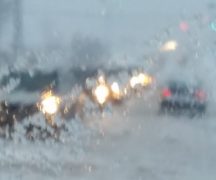By JAN LARSON McLAUGHLIN
BG Independent News
Jake Thornton just recently took up drinking coffee. The timing is fortuitous, since he is one of Bowling Green’s snowplow drivers working 12-hour shifts to keep the city’s roads passable.
On Thursday afternoon, Thornton’s primary responsibility was to keep the outer rim of the city clear enough so people could get to the grocery store and so emergency vehicles could reach them.
“I love it,” Thornton said as he drove the massive truck down Mitchell Road, feet from the deep ditch full of water to the west. “It’s adventurous. When you’re not helping the public on the roads, you’re helping people stuck in their driveways.”
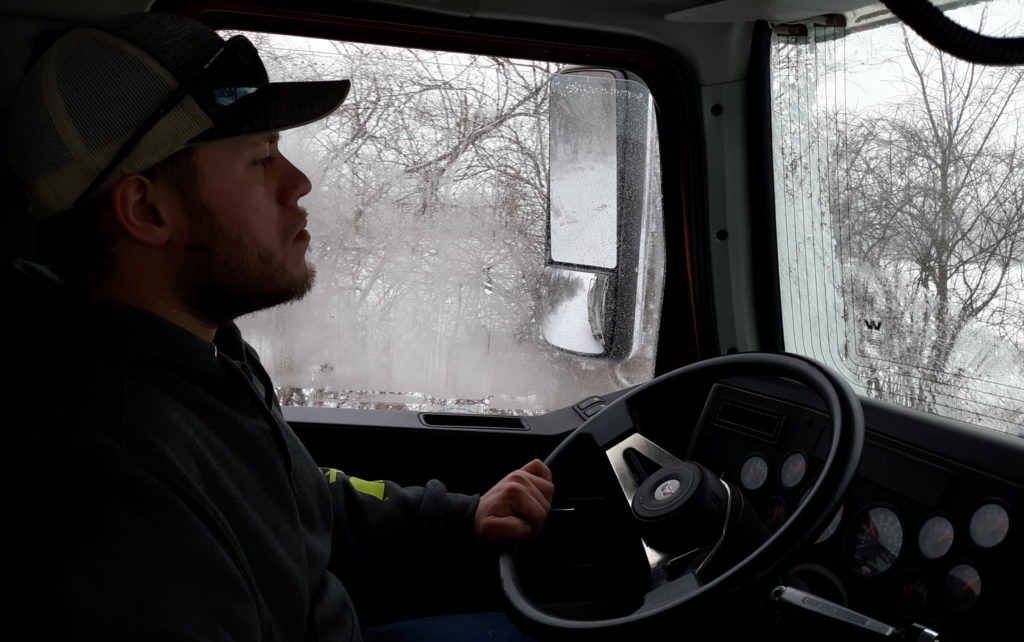
Thornton, of Pemberville, has been a public works equipment operator with the city of Bowling Green for three years. Before that, he worked plowing roads for ODOT for four years. So he knows a bit about keeping roads clear enough for motorists to get where they need to go.
This snowstorm was different than some because of the thick layer of ice underneath. The city trucks were spreading salt, but only at intersections, on overpasses or on roundabouts.
“We try to conserve salt where you can,” Thornton said.
While some agencies use sand or gravel, the city plow drivers only use salt and brine – though the temperatures were too low Thursday for the brine to be effective.
By mid-afternoon, the outer roads circling Bowling Green – like Newton Road – were drifting with snow “snaking” across. Salting those drifts is detrimental, since the salt gives the snow something to hang onto, Thornton said.
The winds in Wood County frequently drift snow from the west. But on Thursday, the winds were coming from the north.
“I’ve always said, it blows from every direction,” Thornton said. And just when the trucks push back the drifting snow on one side of the roadway, “then the wind shifts and it comes back the other direction.”
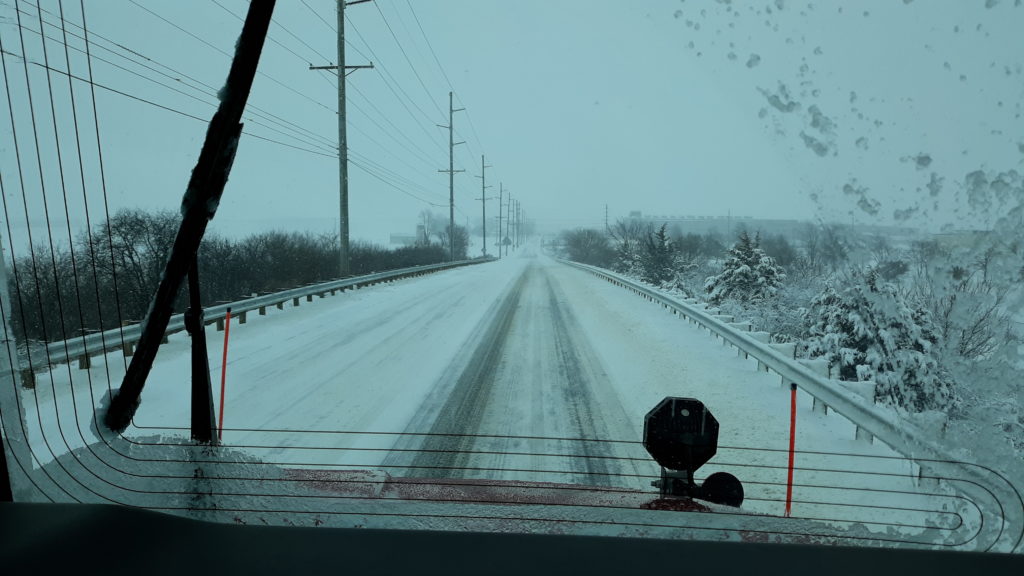
While two snowplow drivers worked to keep the ring around the city clear, plus the industrial parks and outer housing developments – other drivers were assigned to the four wards in the city. On days like Thursday, that meant a continuous pushing of snow off roads, alleys and parking lots.
“We’re trying to keep it passable,” Thornton said. “We all do our absolute best to get the job done.”
“We want the roads cleared off as fast as anyone else,” he said.
But safety is key – so that means the trucks take their time. Plow drivers cringe when motorists try to pass them on slick roads.
“I know it can be pretty irritating if you know you can drive faster than the plow driver,” Thornton said as he drove south on Dunbridge Road. “But the thing to understand is the plow driver is having the same problem as you seeing the road.”
Driving the snowy roads in the dark can be challenging. But then the blinding sunlight on snow can also make it difficult.
“Try to be patient with us,” he said.
“For the most part, everybody’s pretty courteous. Every once in a while there’s someone who thinks they need to pass you,” he said.
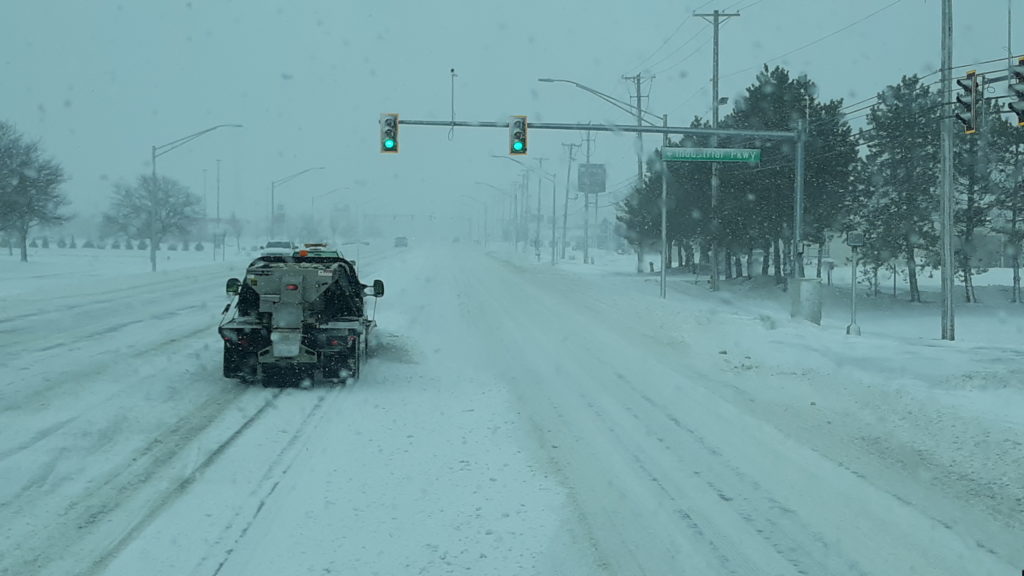
And while drivers scatter salt sections of the road, they have to be careful not to overload their trucks.
“Every pound makes it harder to stop. You have to be careful. This takes longer to stop,” he said of the massive truck.
Thornton has never lost control of his snowplow.
“Knock on wood – I haven’t gone off the road,” he said.
As for plowing down a mailbox or two …
“Not here at the city,” Thornton said. “I’ve come close, real close.”
No plow driver intentionally takes out mailboxes, he said.
“We’re the ones that have to go back out and fix it.”

Plow drivers do hear complaints about their techniques – especially when their plows dump mounds of snow in front of residential driveways.
“It’s not something we like to do. But sometimes we don’t have anyplace else to put it,” Thornton said. “I try to be nice and carry it past the driveway,” by straightening the blade, then angling it back once past the driveway.
It’s the same for cars parked on streets.
“We try our best to plow away from the cars so we don’t plow them in,” he said.
The city has asked that all motorists remove their cars from streets whenever possible before snowstorms.
Thornton has learned the hard way about the consequences of hitting something in the roadway with the plow blade.
“I was always told, if you hit something the blade doesn’t like, it will let you know,” he said. Then one day, he hit a bridge joint and the blade flew up blocking the windshield. Since then, he is quite cautious when plowing overpasses, plus he slows down so he doesn’t shoot snow onto traffic below on I-75.
“I don’t want to throw snow down on cars,” he said as he drove on the Poe Road overpass.
Road crews also hear complaints about the peaks of snow left in the center of Main Street, as crews push the snow into the middle to clear the lanes.

On Thursday afternoon, a “train” of city plows circled from Poe, Dunbridge, and Wooster streets, then Main Street – with each of the staggered trucks pushing the snow left by the previous plow. Doing this, they can clear several lanes at a time, pushing the snow off the roads in some cases, and into the center where there is no place else to put the snow.
“This is a big thing of follow the leader,” Thornton said, taking his place in the middle of the pack.
Those mounds in the middle of Main Street, from Poe to Napoleon roads, won’t be removed by a hydraulic claw until all the side streets are clear.
“It’ll be a couple days before we get stuff cleaned up,” Thornton predicted.
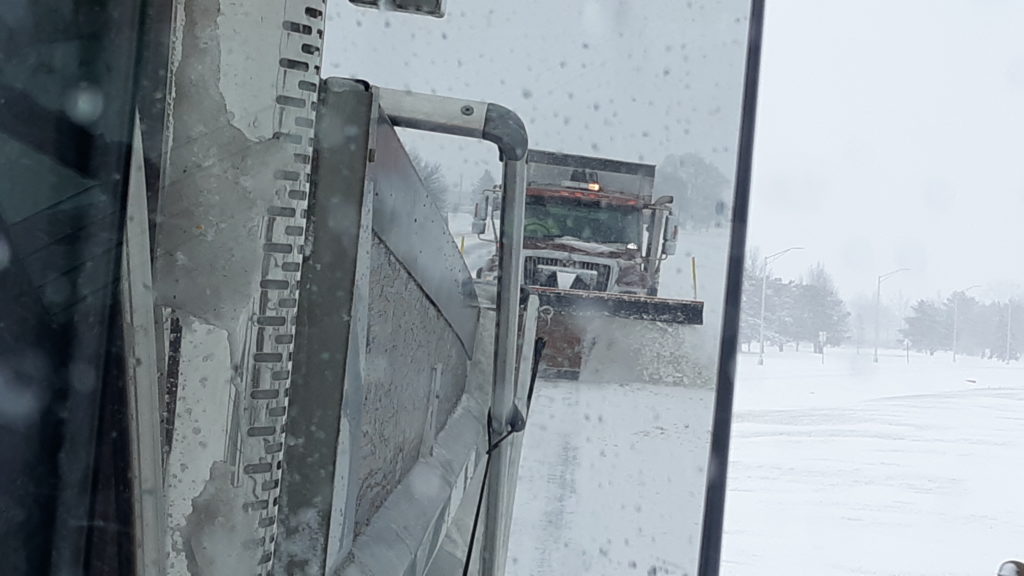
Some roads on the edge of the city are overlapped by both the Bowling Green crews and plow drivers from ODOT and Wood County.
“The more you can help each other out, the better you are,” Thornton said. “We’re all in this together.”
As I post this story, I realize Thornton still has four more hours on the road, keeping the roads passable.
“If I start getting tired, I turn the radio on,” he said.
Or at night, he will rely on the frigid air to revive him.
“I’ll actually plow with the window open to keep me awake,” though he cranks up the truck’s heat so he doesn’t freeze.
Then when Thornton gets home to Pemberville after a 12-hour shift, he has his own driveway to shovel out, he said. But after so long behind the wheel, he doesn’t mind stretching his legs, Thornton said.


